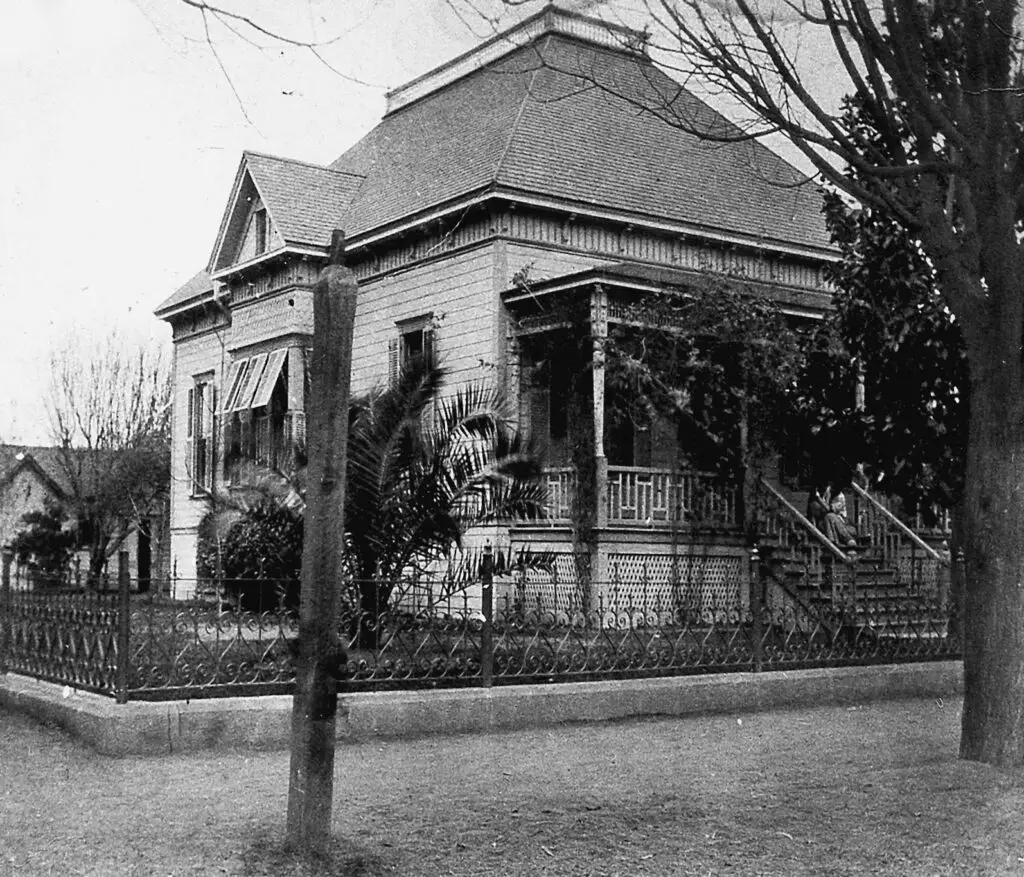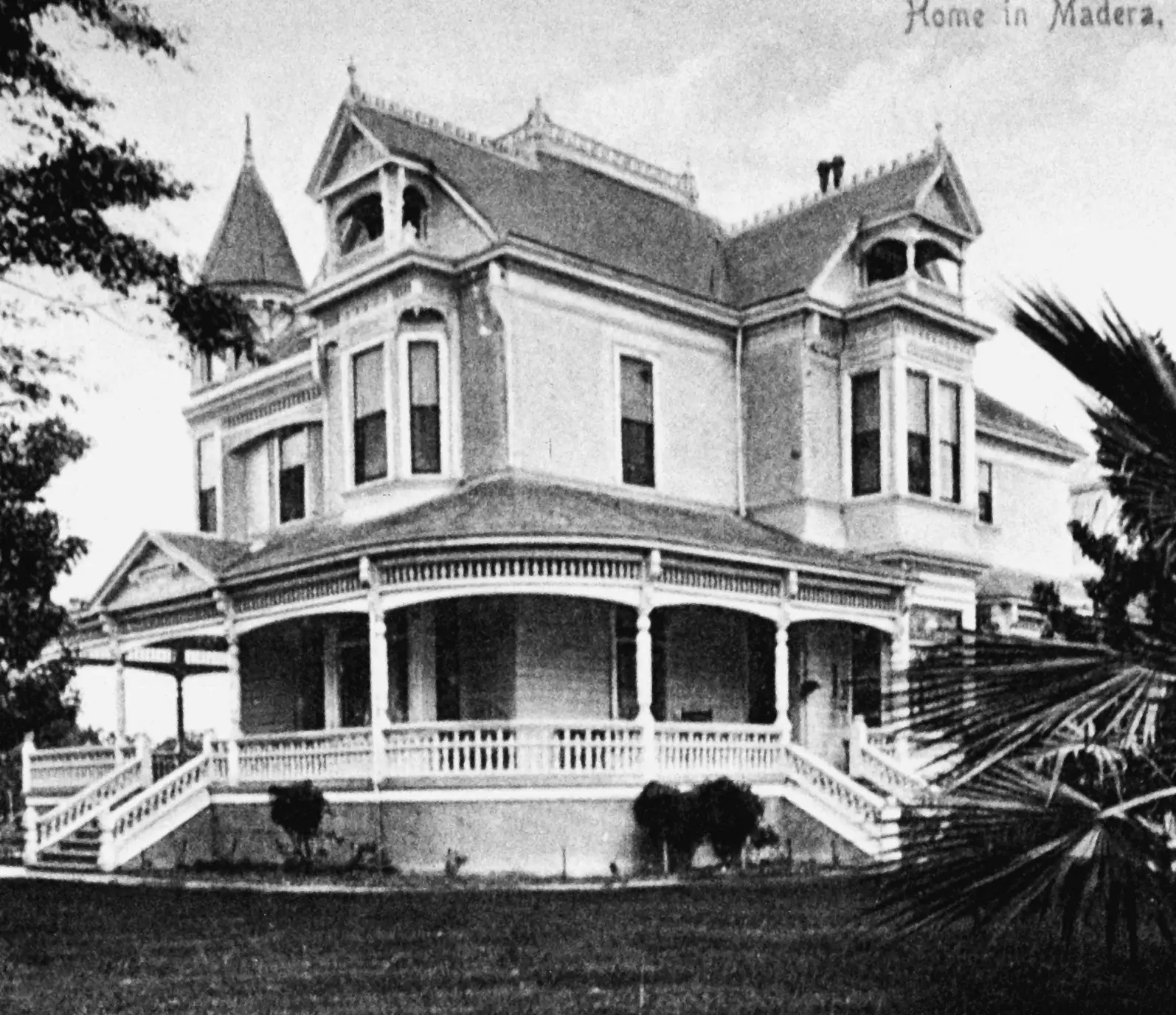Pictured in 1890, this home on North C Street was built by Return Roberts, Madera’s lumber magnate. Dr. Dow Ransom later purchased the home. In the 1950s, the Madera Tribune purchased the home and tore it down, announcing that it was going to build its newspaper plant on the site. Alas, not one newspaper was ever printed there, and apartments now occupy the premises.

Elmer Cox and Return Roberts saved Madera
The two houses sat like majestic displays of the power that lumber once had in Madera. They were located on North C Street between 3rd and 4th Streets. One was built by Elmer Cox and the other by Return Roberts.
Cox and Roberts had a lot in common. Both were self-made men, and both were lumbermen. Their elegant homes sat beside each other on the east side of C Street, and both played important roles in saving Madera from extinction.
Roberts came to Madera first. He had been connected with the little village right from its beginning. When William H. Thurman decided to organize the California Lumber Company, he went to the Commercial and Savings Bank of San Jose to see its president, Return Roberts. He needed money to build a flume from the mountains to the valley so that he could get lumber to the railroad.
Roberts bought Thurman’s idea, and his bank loaned the lumber company the money. Thurman and his associates then built their 56-mile waterslide and named its western terminus “Madera,” the Spanish word for lumber.
Things went well for a while, but in 1878, two years after Thurman began his operation, his company fell into bad times and had to declare bankruptcy. That’s what brought Roberts into the picture. He had to foreclose. By 1880, Roberts had reorganized the California Lumber Company into the Madera Flume and Trading Company, and he came to live here—the town he saved from extinction.
Four years later, Elmer Cox came to Madera. By his own account, he didn’t even have “one coin in his pocket to rub against another,” but he heard there was work to be had here. He first got a job with the Southern Pacific Railroad as a telegrapher and then with the Yosemite Stage and Turnpike Company as its Madera agent. His duties with the latter included making sure that all the passengers got on the stagecoach before it pulled out for Yosemite. That’s how he met Return Roberts. The banker-turned-lumberman often caught the stage to check on his company’s mill and its lumber operations in the mountains.
Roberts was impressed with Cox’s intelligence and industriousness and before long the younger man was working for the older man’s lumber company.
In the meantime, Roberts began work on his C Street palace. He had purchased the property on March 5, 1888, and by 1890 he had his new home built. It was the jewel of Madera real estate. All the while the lumber company built a small house on D Street for his young protégé, Cox.
With the approach of the 1890s, however, trouble raised its ugly head again. As the nation experienced an agricultural depression, the Madera Flume and Trading Company was running out of mountain timber. Once again the lumber industry, the undergirding of Madera’s economy, was being threatened. By 1890, it was nearly out of business.
With operations at a standstill, Roberts and Cox organized yet another company—the Madera Sugar Pine Lumber Company. They acquired the assets of the Madera Flume and Trading Company in 1899, and Cox made a trip to Michigan to see several lumbermen, the most influential being Arthur Hill, owner of a huge tract of forest land adjoining the old MF & T properties. Cox made a deal, and once again Madera was saved by a new lumber company—the Madera Sugar Pine Lumber Company.
Cox and Roberts were joined by several wealthy Michigan lumbermen including Hill. Under Cox’s astute direction, a large sawmill and company town were built in 1899 and 1900 at a place named Sugar Pine, about a mile off the old Yosemite road, very near the south entrance to Yosemite National Park. The lumber flume was extended and lumber began to float to Madera again.
Shortly thereafter, Cox decided to build his own ornate castle on North C Street, next to Roberts’ home. There they lived side by side until the death of Roberts’ wife in 1916. With the passing of his wife, Roberts moved to San Francisco where he died the next year. Dr. Dow Ransom purchased the place on Feb. 7, 1919. From that time on, it became known as the Ransom home. The Madera Tribune purchased the house from the Ransom estate in 1957.
Cox continued to live in his C Street home until 1935 when the Great Depression did what nothing else could do—stamp out the lumber industry in Madera. After the Madera Sugar Pine Company ceased operations, Cox moved to San Francisco where he died on Dec. 5, 1945.
Cox’s home is still standing, but the Roberts/Ransom home was demolished by Dean Lesher, publisher of The Madera Tribune, to make room for a new building, which never came. Instead, apartments took its place.
So, one house stands, and the other is gone, but the memory of the men who built them will never go away. Madera owes them too much to forget them.




